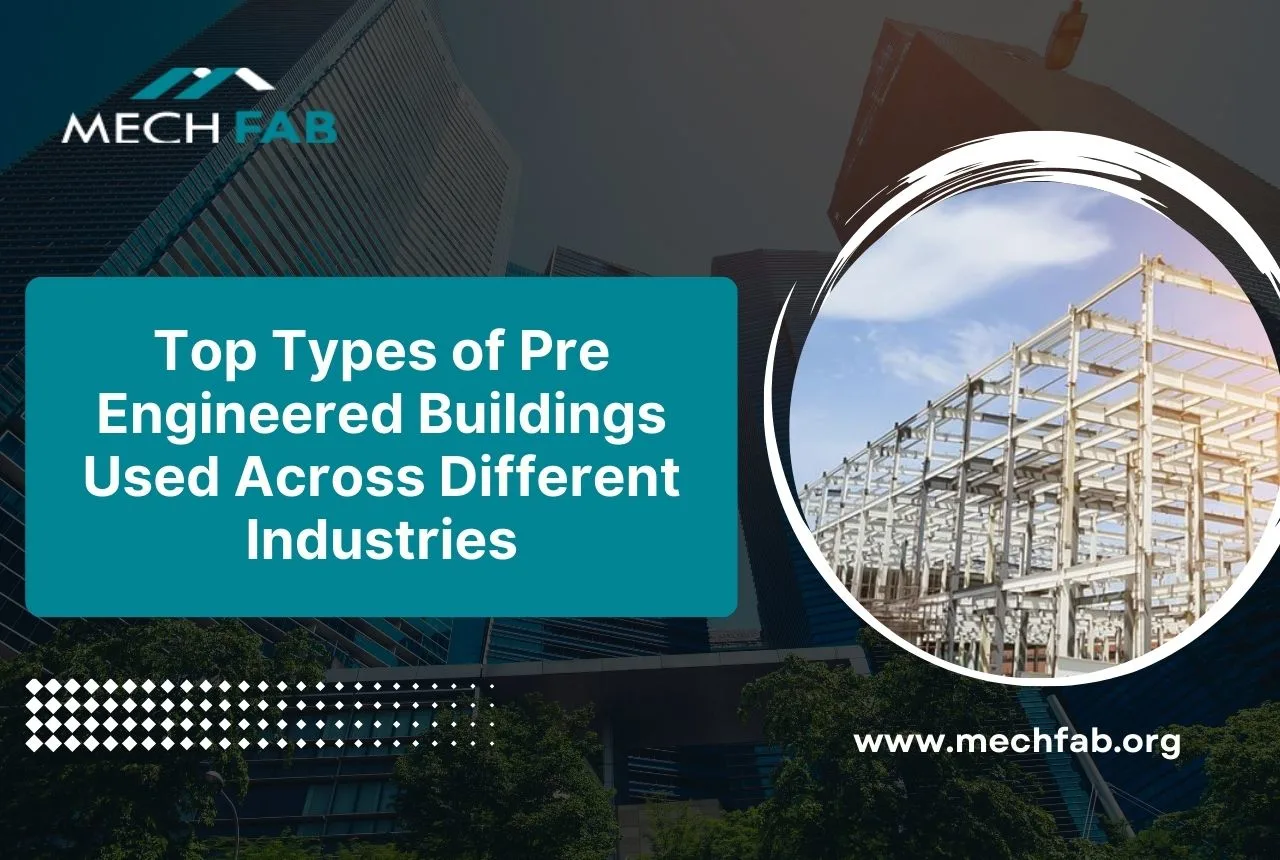Manufacturing process of PEBs are a bit different from convenient construction as pre-engineered steel buildings (PEBs) are a type of construction system where steel components are manufactured off-site and then assembled on-site. These buildings are characterized by their standardized design and efficient construction process. They are widely used in various applications, including industrial facilities, warehouses, commercial buildings, and agricultural structures.
PEBs offer several advantages, such as:
- Cost-effective: The standardized design and off-site manufacturing reduce construction time and labor costs.
- Speed of construction: As the components are prefabricated, on-site assembly is relatively quick.
- Durability and longevity: Steel is a durable material with a long lifespan.
- Flexibility: PEBs can be customized to meet specific requirements.
The manufacturing process plays a critical role in ensuring the quality, efficiency, and cost-effectiveness of PEBs. It involves a series of steps, from design and engineering to fabrication and assembly. This blog post will provide a detailed overview of the major steps involved in the manufacturing process of PEBs.
The Manufacturing Process of PEBs
Design and Engineering
PEB manufacturing begins with the design and engineering phase. This entails translating customer specifications and requirements into comprehensive engineering designs. Engineers collaborate extensively with clients to determine their requirements, including building size, layout, functionality, and aesthetic preferences.
Once the basic design concept has been determined, engineers employ advanced computer-aided design (CAD) software to develop detailed drawings and models. These designs offer details about structural elements, measurements, materials, and connections. Structural analysis software is also used to guarantee that the design can withstand many loads, such as dead loads, live loads, and wind loads.
Throughout the design process, engineers must follow building rules and standards to ensure the PEB’s safety and structural integrity. These codes establish criteria for load calculations, material requirements, and construction practices. Compliance with building codes is required for getting licenses and approvals.
Material Selection and Procurement
The choice of steel is crucial in PEB construction. High-strength steel is often preferred due to its superior strength-to-weight ratio, which allows for thinner, lighter sections without compromising structural integrity. Other types of steel, such as weathering steel or galvanized steel, may be used depending on the specific requirements and environmental conditions.
Quality control is essential throughout the manufacturing process, starting with the procurement of raw materials. Suppliers must be carefully selected to ensure that the steel meets the required specifications. Incoming materials are subjected to rigorous inspections to verify their chemical composition, mechanical properties, and dimensions. Any defects or deviations from standards are identified and addressed to prevent issues during subsequent manufacturing steps.
Steel Processing and Fabrication
Once the raw materials are procured, they undergo a series of processing and fabrication steps to create the individual components of the PEB. This process typically involves the use of advanced equipment, such as:
- CNC cutting machines: These machines use computer-controlled tools to cut steel plates and sections to precise dimensions with high accuracy.
- Punching machines: These machines are used to create holes in steel components for connections, fasteners, and other elements.
- Bending and forming machines: These machines are used to shape steel components into various profiles, such as beams, columns, and trusses.
- Automated welding systems: These systems use robots or other automated equipment to join steel components together efficiently and accurately.
The specific steps involved in steel processing and fabrication may vary depending on the complexity of the PEB design. However, the general process typically includes:
- Cutting: Steel plates and sections are cut to the required dimensions using CNC cutting machines.
- Punching: Holes are punched in the steel components to accommodate bolts, rivets, or other fasteners.
- Bending and forming: Steel components are shaped into the desired profiles using bending and forming machines.
- Welding: The individual components are joined together using automated welding systems to create the structural framework of the PEB.
- Finishing: After welding, the steel components may undergo additional finishing processes, such as painting or coating, to protect them from corrosion and enhance their appearance.
Building the Core Structure
Primary Frame Assembly
The primary frame of a PEB is typically composed of three main structural components:
- Columns: These are the vertical supports that provide stability and carry the load of the roof and walls.
- Rafters: These are the horizontal beams that span between the columns and form the roof structure.
- Purlins: These are secondary beams that are attached to the rafters to support the roof and wall panels.
The assembly of the primary frame is a critical step in PEB construction. It requires precision and careful coordination to ensure the structural integrity of the building. The process typically involves:
- Column erection: The columns are erected in their designated locations and secured to the foundation.
- Rafter installation: The rafters are connected to the tops of the columns using welding or bolted connections.
- Purlin attachment: The purlins are attached to the rafters at specified intervals to provide support for the roof and wall panels.
Welding is a typical method for connecting the main structural components of PEBs. Submerged arc welding is a popular technique because of its high productivity and ability to generate strong, dependable welds. Other welding processes, such as shielded metal arc welding or gas metal arc welding, may be utilized based on the needs.
Ensuring appropriate fit and alignment during primary frame assembly is critical to the PEB’s structural stability and performance. Any misalignment or faults during the assembling process can jeopardise the structure’s integrity and lead to future problems. As a result, precise measurements, templates, and quality control procedures are used to verify that the components are properly assembled.
Secondary Framing and Bracing
Secondary framing is essential in PEB construction because it supports the cladding materials, such as roof and wall panels, while also improving the building’s overall stability. It is made up of smaller steel members that are joined to the central frame.
Common types of secondary framing members include:
- Z-purlins: These are Z-shaped steel sections that are used to support the roof panels.
- C-sections: These are C-shaped steel sections that are used to support the wall panels.
Secondary framework supports the cladding while also distributing loads and providing lateral stability to the building. Bracing systems are installed to withstand wind and earthquake loads, keeping the structure from swaying or collapsing. Braces can be formed of various steel sections, such as angles or channels, and are usually joined to the primary and secondary frame parts to make a rigid structure.
Cladding and Trims – (Subsection under – Building the Core Structure)
Cladding is the exterior covering of a building that serves both functional and aesthetic purposes. In PEBs, cladding provides weatherproofing, protecting the building from rain, wind, and other elements. It also contributes to the building’s overall appearance and can be customized to match specific design preferences.
A variety of cladding materials can be used in PEBs, including:
- Pre-painted steel sheets: These are steel sheets that have been coated with a protective finish, often in a variety of colors and textures.
- Insulated metal panels: These panels are composed of a metal exterior and an insulating core, providing both structural support and thermal insulation.
- Composite panels: These panels are made from a combination of materials, such as steel and fiberglass, and offer a balance of strength, durability, and aesthetics.
Cladding panels are usually moulded into the desired shapes and sizes with specialised equipment. They are subsequently secured to the secondary framing members using screws, rivets, or other fastening methods. To produce a weather-tight enclosure, appropriate alignment, overlap, and sealing are all carefully considered.
Trim elements, such as flashing, coping, and trim boards, are used to complete the margins and transitions between cladding panels. These elements help to protect the building from water penetration and improve its appearance. They are usually composed of the same material as the cladding panels, or a comparable material.
Finishing Touches and Quality Control
Surface Preparation and Painting
Before applying the final finish, the steel surfaces of the PEB must be thoroughly cleaned to remove dirt, grease, and other contaminants that can interfere with paint adhesion. This typically involves a multi-step process, including:
- Degreasing: Removing any oil or grease from the steel surfaces.
- Blasting: Using abrasive materials to remove rust, scale, and other imperfections.
- Priming: Applying a primer coating to provide a base for the topcoat and enhance adhesion.
Once the surface is properly prepared, a high-quality paint coating is applied to protect the steel from corrosion and enhance its appearance. Common types of paint coatings used for PEBs include:
- Zinc-rich primers: These primers contain zinc flakes that provide cathodic protection, helping to prevent rust even if the topcoat is damaged.
- High-performance acrylic finishes: These finishes offer excellent durability, weather resistance, and color retention.
- Powder coatings: These coatings are applied as a powder and then cured using heat, resulting in a durable, scratch-resistant finish.
The choice of paint coating depends on factors such as the specific requirements of the PEB, environmental conditions, and aesthetic preferences.
Quality Control Throughout the Process
Quality control is required throughout the PEB production process to ensure that the finished product meets the highest requirements. Regular inspections and testing take place at all phases, from raw material purchase to final assembly.
Non-destructive testing techniques, such as ultrasonic testing, are used to ensure the integrity of welds and other important components. These technologies enable for the discovery of flaws while preserving the material.
Before shipment, the completed PEB is subjected to a final inspection to confirm that it satisfies all design parameters and quality standards. This includes ensuring appropriate construction, surface quality, and overall structural soundness. Any flaws or non-conformities are found and corrected before the structure is handed to the construction site.
Rewinding the Important Notions
The manufacturing process of pre-engineered steel buildings (PEBs) involves a series of carefully coordinated steps, from design and engineering to fabrication, assembly, and finishing. A well-defined and controlled manufacturing process is crucial for ensuring the quality, efficiency, and cost-effectiveness of PEBs.
By adhering to strict quality control measures and utilizing advanced manufacturing techniques, manufacturers can produce PEBs that meet the highest standards of safety, durability, and performance. PEBs offer numerous benefits for construction projects, including speed of construction, cost-effectiveness, flexibility, durability, and sustainability.






